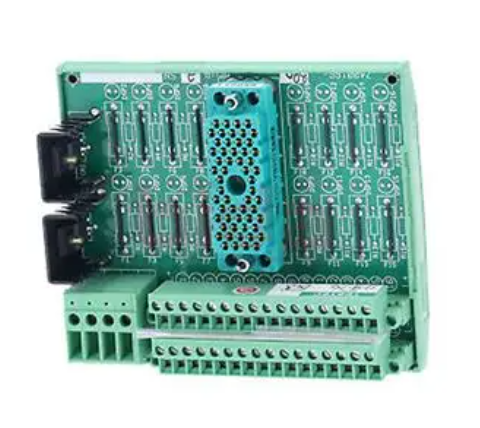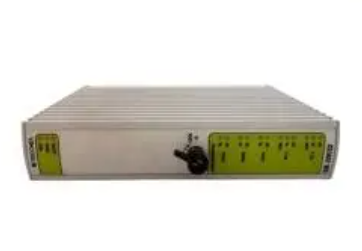

K-WANG


Triconex CM3201S2 Communication Module
Triconex CM3201S2 Communication Module
Product Overview
The Triconex CM3201S2 communication module belongs to the Triconex Safety Instrumented System (SIS) and is designed for high reliability process, safety, and control application scenarios. It is like an information bridge in industrial systems, building a communication channel between Triconex security systems and external monitoring systems, enabling the entire system to operate efficiently, stably, and safely. This module plays an indispensable role in industries with strict requirements for production safety and stability, such as petrochemicals, power energy, pharmaceuticals, metallurgy, etc.

Function characteristics
Rich communication interfaces: Provides various communication interfaces such as Ethernet, RS-232, RS-485, etc., which can easily connect different types of devices and systems, such as sensors, actuators, upper computers, etc., achieving extensive device interconnection.
Multiple protocol support: Supports various industrial communication protocols such as Modbus, PROFIBUS, Modbus TCP, TriStation, etc., enabling data exchange with devices of different brands and types, and adapting to complex industrial network environments.
High speed and reliable data transmission: With high-speed data transmission capability, it can transmit control data, status information, etc. in real time and accurately, ensuring the real-time and stability of the system and meeting the high requirements of industrial control for data transmission.
Network management function: Provides network management functions to facilitate users in configuring, monitoring, and maintaining the network, such as setting network parameters, diagnosing network faults, etc., improving the manageability and availability of the network.
High reliability design: Adopting redundancy design and fault-tolerant mechanisms, such as triple modal redundancy (TMR) architecture, even if a single module fails, the system can still operate normally, ensuring communication continuity and reliability.
High safety: Complies with relevant safety standards such as IEC 61508, suitable for safety critical applications, and can ensure the safety and reliability of the system in hazardous environments.
Technical Parameter
Interface connector type: DB9 connector (RS-485), two RJ-45 connectors with built-in switches.
On site power requirements: 24VDC (11VDC to 28.8VDC).
Size: 99mm × 45mm × 70mm.
Number of supported nodes: 64, limited by IP address.
Supported extended I/O count: 32.
Input voltage: 24VDC
Working temperature: 0 ° C to+60 ° C
Storage temperature: -40 ° C to+85 ° C
Communication port: equipped with 2 Ethernet ports, supporting RS-232 or RS-485 serial communication at the same time
Installation method: Adopting 19 inch rack mounted installation, suitable for common industrial cabinet specifications
Weight: Approximately 1.5kg (3.3lbs)
Memory: Equipped with 32MB of flash memory for storing user programs and data
I/O Capacity: Supports up to 32 analog inputs and 64 digital inputs/outputs
Core functions
Multi protocol communication support: This module can support multiple mainstream industrial communication protocols such as Modbus, Modbus TCP, PROFIBUS, OPC, etc., which enables seamless data exchange with different brands and types of devices and systems, such as distributed control systems (DCS), programmable logic controllers (PLC), etc. Whether it is traditional industrial fieldbus devices or emerging Ethernet based intelligent devices, CM3201S2 can be easily adapted, greatly enhancing the flexibility of system integration.
High speed data transmission: With high-speed data transmission performance, it can achieve real-time and accurate data transmission. Whether it is control instructions, equipment status information, or various key production data, they can be quickly circulated between systems, effectively ensuring the strict requirements of industrial control for data timeliness. In case of emergency, be able to quickly transmit key information to relevant systems to ensure timely response.
System integration and connection: As the interface between the Triconex security system and external devices, it can not only connect to conventional devices such as external hosts and network printers, but also achieve efficient integration with other Triconex Trident v2 systems. Through this module, the Triconex security system can be integrated into the broader infrastructure architecture of the factory, significantly enhancing the system's monitoring, diagnostic, and control capabilities.
Redundant communication guarantee: The module is designed with built-in redundant communication paths. When a communication link fails, the system can automatically switch to the backup link to maintain communication continuity. This redundancy mechanism significantly improves the reliability of the system, which is particularly important for critical task security application scenarios that do not allow communication interruptions.
Precautions
Installation environment requirements: Although the module has a certain degree of environmental adaptability, it is still necessary to choose a well ventilated, dry, and temperature stable location as much as possible during installation, avoiding installation in direct sunlight, humidity, or locations with severe vibrations to prevent adverse effects on module performance and service life.
Power supply stability: It is essential to ensure a stable 24VDC power supply for the module. Excessive power fluctuations can cause abnormal or even damaged module operation. It is recommended to equip appropriate voltage regulation and filtering devices at the power access end to ensure the quality of the power supply.
Communication cable connection: When connecting communication cables, it is necessary to strictly follow the interface type and cable specifications for correct connection, and ensure that the cable connection is firm. Poor quality or improperly connected cables may cause communication failures such as signal attenuation and data loss.
Software version compatibility: When upgrading or integrating modules with other systems, it is necessary to carefully confirm the compatibility of the software version used with the module hardware and other related systems to avoid system failures caused by software incompatibility.
Application area
Petrochemical industry: In the petrochemical production process, it is used to connect various safety instrumentation equipment, such as emergency shutdown systems, fire alarm systems, etc., to achieve safety monitoring and control of the production process and prevent accidents from occurring.
Power industry: used in the fields of substation automation, power grid dispatch automation, etc. in the power system, to achieve communication and data exchange between equipment, and ensure the stable operation of the power system.
Pharmaceutical industry: Used in the pharmaceutical production process to connect production equipment, quality testing equipment, etc., to achieve automated control and quality monitoring of the production process, ensuring drug quality and safety.
Other industrial fields: It is also widely used in metallurgy, papermaking, food and beverage and other industrial fields to achieve industrial automation control and communication interconnection between equipment.

- YOKOGAWA
- Energy Access
- Renewable Integration
- Energy Subsidies
- Energy and Water
- Net zero emission
- Energy Security
- Critical Minerals
- A-B
- petroleum
- Mine scale
- Energy and Gender
- Covid-19
- man-machine
- Reliance
- ADVANCED
- SEW
- ProSoft
- WATLOW
- Kongsberg
- FANUC
- VSD
- DCS
- PLC
- Sewage treatment
- cement
- Yaskawa
- Woodward
- BOSCH Rexroth
- MOOG
- General Electric
- American NI
- Rolls-Royce
- CTI
- Honeywell
- EMERSON
- Automobile market
- xYCOM
- Motorola
- architecture
- Industrial information
- New energy
- electricity
- Construction site
- HIMA
- ABB
- Rockwell
- Schneider Modicon
- Siemens
- MAN
- GE
- TRICONEX
- Control Wave
- ALSTOM
- AMAT
- STUDER
- KONGSBERG
- MOTOROLA
- DANAHER MOTION
- Bentley
- Galil
- EATON
- MOLEX
- Triconex
- DEIF
- B&W
- ZYGO
- Aerotech
- DANFOSS
- KOLLMORGEN
- Beijer
- Endress+Hauser
- schneider
- Foxboro
- KB
- REXROTH
- YAMAHA
- Johnson
- Westinghouse
- WAGO
- TOSHIBA
- TEKTRONIX
-
Kollmorgen S33GNNA-RNNM-00 - Brushless Servo Motor
-
Kollmorgen 6sm56-s3000-g-s3-1325 - Servo Motor
-
Kollmorgen AKM52K-CCCN2-00 - Servo Motor
-
Kollmorgen PSR3-230/75-21-202 - Power Supply
-
Kollmorgen akm24d-anc2r-00 - Servo Motor
-
Kollmorgen AKM22E-ANCNR-00 - Servo Motor
-
Kollmorgen S60300-550 - Servo Drive
-
Kollmorgen B-204-B-21 - Servomotor
-
Kollmorgen AKM21E-BNBN1-00 - Servo Motor
-
Kollmorgen TT2953-1010-B - DC Servo Motor
-
Kollmorgen pa8500 - Servo Power Supply
-
Kollmorgen BDS4A-210J-0001-207C2 - Servo Drive
-
Kollmorgen TTRB1-4234-3064-AA - DC Servo Motor
-
Kollmorgen MH-827-A-43 - Servo Motor
-
Kollmorgen AKM24D-ACBNR-OO - Servo Motor
-
Kollmorgen 00-01207-002 - Servo Disk DC Motor
-
Kollmorgen AKM21C-ANBNAB-00 - Servo Motor
-
Kollmorgen PSR3-208/50-01-003 - Power Supply
-
Kollmorgen 6SM56-S3000 - Servo Motor
-
Kollmorgen DBL3H00130-B3M-000-S40 - Servo Motor
-
Kollmorgen 6SN37L-4000 - Servo Motor
-
Kollmorgen AKM65K-ACCNR-00 - Servo motor
-
Kollmorgen 6SM56-L3000-G - Servo Motor
-
Kollmorgen AKMH43H-CCCNRE5K - Servo Motor
-
Kollmorgen PSR4/52858300 - Power Supply
-
Kollmorgen KBM-79H03-E03 - Direct Drive Rotary Motor
-
Kollmorgen AKM33E-ANCNDA00 - Servo Motor
-
Kollmorgen U9M4/9FA4T/M23 - ServoDisc DC Motor
-
Kollmorgen AKM13C-ANCNR-00 - Servo Motor
-
Kollmorgen AKM43L-ACD2CA00 - Servo Motor
-
Kollmorgen AKM54K-CCCN2-00 - Servo Motor
-
Kollmorgen M-605-B-B1-B3 - Servo Motor
-
Kollmorgen AKD-P00606-NBAN-0000 - Rotary Drive
-
Kollmorgen 6SM-37M-6.000 - Servo Motor
-
Kollmorgen A.F.031.5 - Sercos Interface Board
-
Kollmorgen 918974 5054 - Servo PWM
-
Kollmorgen U12M4 - ServoDisc DC Motor
-
Kollmorgen AKD-B00606-NBAN-0000 - Servo Drive
-
Kollmorgen MV65WKS-CE310/22PB - Servo Drive
-
Kollmorgen 65WKS-CE310/22PB - Servo Drive
-
Kollmorgen EM10-27 - Module
-
Kollmorgen S64001 - Servo Drive
-
Kollmorgen CR03200-000000 - Servo Drive
-
Kollmorgen 6SM57M-3000+G - Servo Motor
-
Kollmorgen BDS4 - Servo Drive
-
Kollmorgen AKD-P00306-NBEC-000 - Servo Drive
-
Kollmorgen AKD-B01206-NBAN-0000 - Servo Drive
-
Kollmorgen STP-57D301 - Stepper Motor
-
Kollmorgen 6SM37L-4.000 - Servo Motor
-
Kollmorgen 44-10193-001 - Circuit Board
-
Kollmorgen PRDR9SP24SHA-12 - Board
-
Kollmorgen PRD-AMPE25EA-00 - Servo Drive
-
Kollmorgen DBL3N00130-0R2-000-S40 - Servo Motor
-
Kollmorgen S406BA-SE - Servo Drive
-
Kollmorgen AKD-P00607-NBEI-0000 - Servo Drive
-
Kollmorgen AKD-P01207-NBEC-0000 - Servo Drive
-
Kollmorgen CR03550 - Servo Drive
-
Kollmorgen VSA24-0012/1804J-20-042E - Servo Drive
-
Kollmorgen N2-AKM23D-B2C-10L-5B-4-MF1-FT1E-C0 - Actuator
-
Kollmorgen 04S-M60/12-PB - Servo Drive
-
Kollmorgen H33NLHP-LNW-NS50 - Stepper Motor
-
Kollmorgen A-78771 - Interlock Board
-
Kollmorgen AKM43E-SSSSS-06 - Servo Motor
-
Kollmorgen AKD-P00607-NBEC-0000 - Servo Drive
-
Kollmorgen E21NCHT-LNN-NS-00 - Stepper Motor
-
Kollmorgen cr10704 - Servo Drive
-
Kollmorgen d101a-93-1215-001 - Motor
-
Kollmorgen BDS4A-203J-0001-EB202B21P - Servo Drive
-
Kollmorgen MCSS23-6432-002 - Connector
-
Kollmorgen AKD-P01207-NACC-D065 - Servo Drive
-
Kollmorgen CK-S200-IP-AC-TB - I/O Adapter and Connector
-
Kollmorgen CR10260 - Servo Drive
-
Kollmorgen EC3-AKM42G-C2R-70-04A-200-MP2-FC2-C0 - Actuator
-
Kollmorgen BDS5A-206-01010-205B2-030 - Servo Drive
-
Kollmorgen s2350-vts - Servo Drive
-
Kollmorgen AKM24D-ANC2DB-00 - Servo Motor
-
Kollmorgen E31NCHT-LNN-NS-01 - Stepper Motor
-
Kollmorgen PRD-0051AMPF-Y0 - Servo Board
-
Kollmorgen TB03500 - Module
-
Kollmorgen 60WKS-M240/06-PB - Servo Drive
-
Kollmorgen M21NRXC-LNN-NS-00 - Stepper Motor
-
Kollmorgen H-344H-0212 - Servo Motor
-
Kollmorgen MCSS08-3232-001 - Connector
-
Kollmorgen AKM33H-ANCNC-00 - Servo Motor
-
Kollmorgen PA-2800 - Power Supply
-
Kollmorgen MTC308C1-R1C1 - Servo Motor
-
Kollmorgen PRDR0091300Z-00 - Capacitor Board
-
Kollmorgen BDS4A-206J-0024/01502D79 - Servo Drive
-
Kollmorgen S20330-VTS - Servo Drive
-
Kollmorgen S20250-CNS - Servo Drive
-
Kollmorgen SBD2-20-1105-WO - Servo Drive Board
-
Kollmorgen M405-C-A1--E1 - Servo Motor
-
Kollmorgen PRD-PB805EDD-00 - Servo Drive
-
Kollmorgen 6SM57S-3.000-J-09-HA-IN - Servo Motor
-
Kollmorgen AKM33H-ANCNDA-00 - Servo Motor
-
Kollmorgen PCB-00030200-04 - PCB
-
Kollmorgen H22SSLB-LNN-NS-02 - Stepper Motor
-
Kollmorgen BJRL-20012-110001 - Module
-
Kollmorgen BDS4A-206J-0001404A - Servo Drive
-
Kollmorgen H-342-H-0802 - Servo Motor
-
Kollmorgen CR10561 - Servo Drive
-
Kollmorgen BDS5A-206-00010-205B2-030 - Servo Drive
-
Kollmorgen BDS5A-206-00010-207B-2-030 - Servo Drive
-
Kollmorgen mcss08-3224-001 - Connector
-
Kollmorgen M-207-B-23-B3 - Servo Motor
-
Kollmorgen PRD-0041200Z-S0 - Encoder/Resolver Card
-
Kollmorgen MH-225-G-61 - Motor
-
Kollmorgen MT308B1-T1C1 - Servo Motor
-
Kollmorgen BDS4A-240J-0001604C83 - Servo Drive
-
Kollmorgen 6SM57-S-3000 - Servo Motor
-
Kollmorgen N-T31V-15-5B-6-MF3-FT1E-C251 - Actuator
-
Kollmorgen PRD-0051AMPA-X0 - Servo Board
-
Kollmorgen CF-SS-RHGE-09 - Cable
-
Kollmorgen DIGIFAS7204 - Servo Drive
-
Kollmorgen S30101-NA - Servo Drive
-
Kollmorgen DIGIFAS7201 - Servo Drive
-
Kollmorgen PRD-0051AMPA-Y0 - Servo Board
-
Kollmorgen AKM23D-EFCNC-00 - Servo Motor
-
Kollmorgen SE10000 - Servo Drive
-
Kollmorgen PSR4/5A-112-0400 - Power Supply
-
Kollmorgen AKM31H-ANCNC-01 - Servo Motor
-
Kollmorgen M-203-B-93-027 - Servo Motor
-
Kollmorgen CP-SS-G1HE-05 - Connector
-
Kollmorgen AKM42G-ASCNR-02 - Servo Motor
-
Kollmorgen DBL4N00750-B3M-000-S40 - Servo Motor
-
Kollmorgen R3-BK23-152B-12-PL-ASE-BS115 - Actuator
-
Kollmorgen MH-427-B-61 - Motor
-
Kollmorgen cr06902 - Servo Drive




